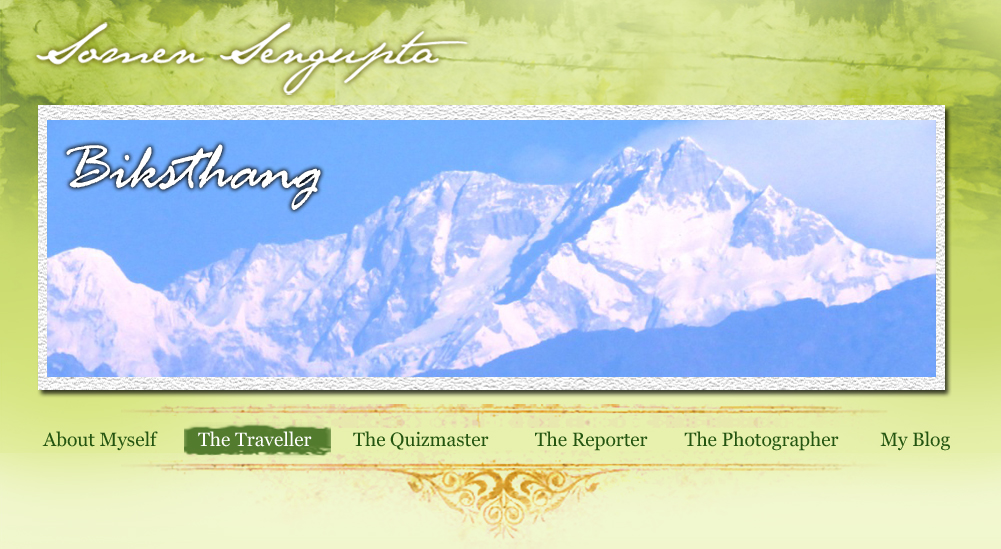| BIKSTHANG:THE BLESSED LAND |
|
Biksthang is an experience of a lifetime; it needs to be told, says Somen Sengupta
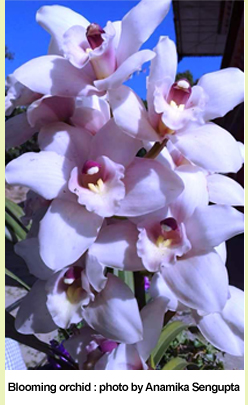 A copy of the newspaper that I picked from NJP station that morning was read and reread till 6 pm in that kingdom of silence. Outside my well-furnished accommodation, the world was sunk in a penance of eternal peace. In that entire resort, located 4,200 ft above sea level, we were the only guests staying in that night. The wooden walls and floor of the tastefully decorated room forced us to wonder — are we at the right place? Has it been a blunder on our part to select the less popular Biksthang over Kaluk or Pelling which were much more popular with tourists who visited that part of Sikkim? There could be no certain answer to that. “We will have to wait till morning,” I told my hardly-convinced wife. Neither of us had any idea about the serenity that awaited us.
A copy of the newspaper that I picked from NJP station that morning was read and reread till 6 pm in that kingdom of silence. Outside my well-furnished accommodation, the world was sunk in a penance of eternal peace. In that entire resort, located 4,200 ft above sea level, we were the only guests staying in that night. The wooden walls and floor of the tastefully decorated room forced us to wonder — are we at the right place? Has it been a blunder on our part to select the less popular Biksthang over Kaluk or Pelling which were much more popular with tourists who visited that part of Sikkim? There could be no certain answer to that. “We will have to wait till morning,” I told my hardly-convinced wife. Neither of us had any idea about the serenity that awaited us.
Our day started at NJP station of Bengal around 9 am in a car sent by the resort managers. I checked with the local cab operators and found out that Biksthang was not that well-known a place; they were clever to charge hefty for traveling there. The car sent from the resort glided the foothills of Himalayas. It was an indispensable part of every tour in the region. From the Coronation Bridge over river Teesta, the car moved towards Sikkim and soon crossed Jorethang. When we finally arrived at Biksthang, it was afternoon and very cloudy.
Like I did during every visit I had made to Sikkim, I expectantly asked driver — “Is it visible in this morning?” Sadly, this time too, the reply was, “It is, but it is not that clear as it should be.” Even during my past expeditions, dark patches of clouds had deprived me of a clear view of the brightest signature of Sikkim, the ‘protector deity of this land’. We were talking about Mount Khangchendzonga, perhaps the most beautiful peak of Himalayas. It looms large over Sikkim on every side. Visiting Sikkim and not viewing Khangchendzonga is something like not getting a glimpse of the deity even after entering a temple. “God knows when your addiction of Khangchendzonga will end! Only then will we be able to select the right place to spend money and time on,” said my displeased wife. As night was gradually rolling into deeper solitude, I switched on the bedside lamp and once again opened the much-read-and-discarded copy of the morning newspaper. Skimming through reports about political mess and social kerfuffle, I prayed to the 8th century Mahaguru Padmasambhava — the Buddhist monk who once blessed this hidden land known as Denjong — for help. I sought his blessing for another visit to Khangchendzonga; domestic peace was already at stake in my house!
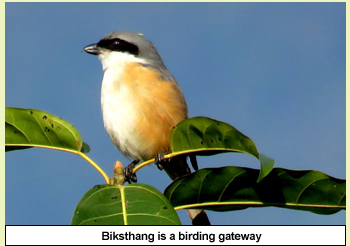 Next morning, my wife ruthlessly pulled me out of bed. “Look, there is a beautiful, yellow bird resting at our window — click a picture,” she said. I took no time to obey her command; the bird was rather unique. I was aware that this part of Sikkim was rich in biodiversity. It had exceptional birds. As my camera rolled on, the little bird behaved so gently that even a novice photographer like me was in utter comfort. Next morning, my wife ruthlessly pulled me out of bed. “Look, there is a beautiful, yellow bird resting at our window — click a picture,” she said. I took no time to obey her command; the bird was rather unique. I was aware that this part of Sikkim was rich in biodiversity. It had exceptional birds. As my camera rolled on, the little bird behaved so gently that even a novice photographer like me was in utter comfort.
Last afternoon, while checking into the resort, I had looked at a long list displayed at the reception. It had names of the rare birds often sighted from there. From the official website of Sikkim tourism, I had taken note that that was a place from where more than 200 species of birds are visible. The rich avifauna of Sikkim is often known as bird watcher’s paradise. I had heard that birds like maroon backed accentor and red faced liocichla were also in sight.
Soon, pure English breakfast was served in a glass-walled dining hall facing the horizon where on a clear day Khangchendzonga appears like a queen. I called a taxi to go around. The place where we are parked was shadowed by two Buddhist monasteries and one holy cave which is one of the most sacred pilgrimage to Buddhist people of this region. “Get ready to see a hidden side of our cultural heritage,” I said to my son and wife. Unlike me, they are ever enthusiastic for an outing like this. It was the last week of December; the chill in the air was bone rattling. The pervious night, my smart phone had recorded that it was below three degrees Celsius. At 10 am, my fingers were so frozen that I was not able to click the shutter of my camera. Soon, a charming boy came to knock at the resort gate. “I am your driver. Are you all ready,” he asked with a smile. We were ready.
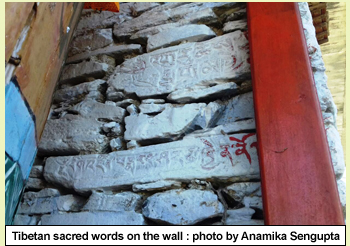 Meanwhile, I got some information on Biksthang. I could not resist my habit of sharing those details with wife. “Do you know this is the place where once a tiger ate a cow? At least the folklore says so,” I said. My wife and son were waiting for something just like that. My teenaged son said, “Is that history or legend ?” I said, “It is derived from a Lepcha word “Bikmon”. That’s where Biksthang came from. However, another story goes that a Bhutia word “Lhopos,” meaning “A place with wide variety of special stones” is the origin of Biksthang.” I said, doing my best to show that I was a Google-savvy dad. My son did little more surfing on the net than I did. He proclaimed that that place was famous for millet. The official name of the place was Chuchen, meaning “Big Lake”. Soon, the smaller monastery was in sight. Meanwhile, I got some information on Biksthang. I could not resist my habit of sharing those details with wife. “Do you know this is the place where once a tiger ate a cow? At least the folklore says so,” I said. My wife and son were waiting for something just like that. My teenaged son said, “Is that history or legend ?” I said, “It is derived from a Lepcha word “Bikmon”. That’s where Biksthang came from. However, another story goes that a Bhutia word “Lhopos,” meaning “A place with wide variety of special stones” is the origin of Biksthang.” I said, doing my best to show that I was a Google-savvy dad. My son did little more surfing on the net than I did. He proclaimed that that place was famous for millet. The official name of the place was Chuchen, meaning “Big Lake”. Soon, the smaller monastery was in sight.
Like any Buddhist place of worship in the Himalayas where Vajrayana Buddhist cult of Tibet overpowers all other cultural influences, this place was also decorated with colourful Buddhist prayer flags. We took a quick round all over the monastery, meeting young Buddhist pupils taking lesson of theology. The temple was shining when suddenly, clouds started moving. “This is a good sign; it shows you will have luck tomorrow to encounter Khangchendzonga,” said my wife, who never misses a chance to rub salt on my wounds. We soon arrived at a hill top. There stood Rinchenpong monastery, one of the most important heritage sites of Sikkim.
This third oldest monastery of Sikkim was set up in 1730 by Ngadakpa Lama and some monks. The biggest attraction of the monastery is that it enshrines one of the very few statue of Adi Buddha in blue also termed as primordial Buddha the oldest form of Buddha. Here, he is naked and in gesture of meditation while embracing a female figure. It is an expression of a great lesson of tantric Buddhism. Unfortunately, I found the door locked. I ran to the house of the chief monk and requested him to open the door, promising him that I won’t click pictures of Adi Buddha. The request was put down with a soft smile at once.
 The monastery is small in size and typically built of stone and wood with kalachakra prayer wheels on both sides. The Tibetan sacred scripts carved on its walls are centuries old. From here, the vast horizon shows Khangchendzonga — if one goes on the right day. I was there on a wrong day, it seems. The monastery is small in size and typically built of stone and wood with kalachakra prayer wheels on both sides. The Tibetan sacred scripts carved on its walls are centuries old. From here, the vast horizon shows Khangchendzonga — if one goes on the right day. I was there on a wrong day, it seems.
My Buddhist pilgrimage was yet to touch another holy place near Rinchenpong. This time, it was the holy cave of Kadasong Phu. The history of Sikkim is full of religious text and philosophy. “You were talking about Guru Padmasambhava. Is this cave related to him,” my wife asked me when we started scaling the rock to reach the cave. I was having a tough time in scaling the stiff steps of the stairs but that question ignited my curiosity. “Oh yes! It is. And inside the cave, we will see his statue as well,” I said.
In 8th century AD, Mahaguru Padmasambhava demarked four holy caves in four cardinal directions as an abode of four protective divinities of Sikkim. One of them was Kadasong Phu. We soon scaled it up to reach the cave where inside the stone wall, a small yet majestic statue of Padmasambhava is housed. There are several stone-carved Buddhist scriptures written on the rock beds and the entire area is decorated with prayer flags. Our return to the resort was eventless. Some more clouds were coming down, giving more passage to the cold winds to blow. Another night came to Biksthang with more silence and more pensiveness in the air. The dinner was excellent and the cold weather was fine to enjoy.
Next morning, along with Biksthang, I was also blessed by Mahaguru Padmasambhava. My wife, an early riser, was quick in judging that the cavern of clouds was slowly moving away and Kabru1 and Kabru2 — two of the most magnificent peaks of Khangchendzonga range — were standing clear before us. “You, the blessed child of Padmasambhava, please wake up and offer your submission to Khangchendzonga,” she said. Opening eyes and looking over the window, I had no reason to complain; she was there. When we all were there in the lawn to encounter 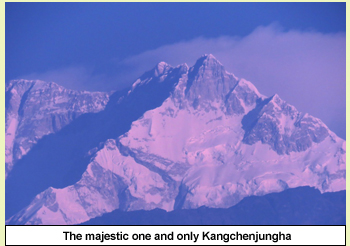 the most beautiful snow peaks of Himalayas, the entire range was clear. The magic of Khangchendzonga was quickly engrossing us with its massive shape and unimaginable dominance over the horizon. Staring from Kabru, one after another the peaks were flashing under the sun, uncovering the last single piece of the mystic curtain. the most beautiful snow peaks of Himalayas, the entire range was clear. The magic of Khangchendzonga was quickly engrossing us with its massive shape and unimaginable dominance over the horizon. Staring from Kabru, one after another the peaks were flashing under the sun, uncovering the last single piece of the mystic curtain.
Khangchendzonga is actually a conglomeration of five massive peaks out of which four are 8,000 mt plus. West Sikkim is a location from where its distance is minimum from any other parts of India. So, one can imagine how it feels when such a sight is unfolded before the naked eyes. The central Khangchendzonga, the highest peak of the family, is of 8,685 mt. It is the third highest peak of the world. Till 1853, it was the highest.
The range of Khangchendzonga, as seen from Sikkim, looks bigger yet it’s ear to ear view is shorter than when it is seen from Darjeeling of Bengal. The attraction is its massive size and nearness that give a feel that one can just run and scale it. I ran in various corner to catch it from different angles. And I noticed that the ground below was covered with colorful flowers and orchids. I had failed to notice this face of Biksthang in the past two days as I was too sad about not having seen Khangchendzonga.
As I ran over the grass, my wife kept on clicking magnolia, hemlocks, and rhododendrons. My time in Biksthang was over by 11 am. By that time, I had enjoyed breakfast under the shadow of it. I could not recall what exactly I had eaten but I can say that it was one of the best morning meals that I have had in my life. “So your Sikkim expedition has not failed this time,” my son reminded me before I took my eyes off Khangchendzonga. I was about to tell him that in Sikkim, Khangchendzonga is not just a mountain. To Sikkim, it is what soccer is to Brazil. It runs in every stream of their culture and legacy. At the time of leaving, I felt speechless and struggled to hide a few tear drops. Such is the impact of Khangchendzonga.
This article was published in The Pioneer on 17th June 2018
Click here to view the original article
|
